"Edenton" Cannon Is Back Home
The "Edenton" was presented to the public at a ceremony held today on the green of the historic 1767 Chowan County Courthouse in Edenton, NC. The "Edenton" will shortly be moved and displayed beside the "St. Paul" in Edenton’s Colonial Park on Edenton Bay.

"Edenton" Cannon Before The Ceremony
Peter Rascoe, Edenton-Chowan Special Projects Officer, was master of cermonies at the Presentation of the "Edenton", the bronze six-pounder cannon manufactured in 1862 at Tredegar Foundry using the original bell of the National Historic Landmark 1767 Chowan County Courthouse. The "Edenton" was one of four cannons manned by the Edenton Bell Battery.

Pledge Of Allegiance To The Flag Of The United States Of America

Blessing Of The Occasion - Reverend Robert C. White
The Edenton Bell Battery was organized in March, 1862 by Edenton lawyer Captain William Badham, Jr. and his brother-in-law Lieutenant John M. Jones. Lieutenant Nelson McLees and his men from Tyrrell County joined the battery, as did men from Washington County. The unit was officially incorporated into Confederate service as Company B, Third Battalion. North Carolina Light Artillery.

Toast To The Old North State - Harry Thompson, Curator, Port o' Plymouth Museum

Welcome and Recognitions - Peter Rascoe
Encamped in Richmond without cannon, and after a threat to be incorporated into the infantry, Captain Badham dispatched Lieutenant Jones back to Edenton in April 1862 to solicit metal to cast cannon for the unit. Jones was successful in convincing the major institutions and residents of the town to donate their bells. Upon Jones' return to Richmond, Tredegar Foundry cast four bronze cannon on April 28, 1862 using the metal obtained from the bells of Edenton.

Civil War Veterans Greeting Special Music - Carteret Grays, Worth Mason, Leader.

Jimmy Hardison, Representing Descendants Of Area Civil War Veterans
The men of the battery voted names for each cannon for which particular bells had actually been used to cast. A six-pounder was named the "Edenton" since the Chowan County Courthouse bell was used to cast it. Another six-pounder was named the "Columbia" in honor of McLees's men from Tyrrell County (Columbia being the county seat). A twelve-pounder howitzer was named the "Fannie Rouhlac" after a female leader of the Edenton Methodist Church, which bell was used to pour that cannon. And finally another twelve-pounder was named the "St. Paul" after St. Paul's Episcopal Church which donated its large bell used to make this cannon.
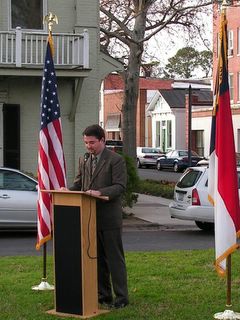
Office Of NC Senate President Pro Tem Marc Basnight - Chris Dillon, Director Of Special Projects
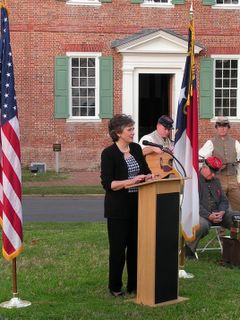
Office Of United States Senator Elizabeth Dole - Janet Bradbury, Eastern Regional Director
The battery saw action in Virginia with the Army of Northern Virginia at Winchester, Culpeper Courthouse, the Seven Days Battle, and in protecting a vital bridge south of the Battle of Fredericksburg. Transferred to North Carolina in 1863 to oppose Union advances towards the Wilmington and Weldon Railroad, the battery then saw action at Whitehall Bridge, Goldsboro, and Kinston. That same year the unit was garrisoned at Fort Holmes on Smith's Island (now Bald Head) and served as a flying battery for protection of Southern blockade runners transiting Old Inlet at the mouth of the Cape Fear River.
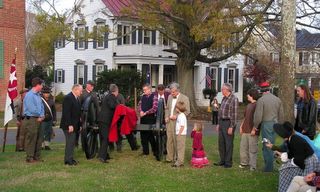
Recognition Of Descendants Of Edenton Bell Battery
After the fall of Fort Fisher in January 1865, the battery evacuated to Fort Anderson in Brunswick County, NC. Subsequently engaged in a fighting retreat up the western bank of the Cape Fear River towards Wilmington, the "St. Paul" and its gun crew were captured on February 20, 1865 by Federal forces at the Battle of Town Creek near Orton Plantation.

Unveiling Of The "Edenton" Cannon
The remainder of the battery saw action around Wilmington and in the battles of Bentonville and Cox's Bridge. The remaining men of the battery and the six-pounder "Edenton" were surrendered with the Army of Tennessee under General Joseph E. Johnston on April 26, 1865. The "Fannie Roulac" and the "Columbia" are rumored to have been dumped into the Eno River during the retreat westward after the Battle of Bentonville.

Photo Op For Dignataries Present
During the years following the War and the return home of the surviving men of the battery, the whereabouts of the four cannon remained a mystery for generations. Not until 1990 did a Civil War reenactor from Edenton discover the six-pounder "Edenton" at Shiloh National Military Park in Shiloh, Tennessee. In 1999, the twelve-pounder "St. Paul", was discovered stored at Old Fort Niagara in Youngstown, New York.

Portion Of The Crowd
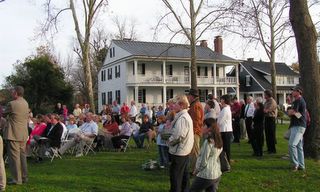
By The End It Was Standing Room Only
On June 13, 2001, the Old Fort Niagara Association transferred the "St. Paul" by loan to Peter Rascoe, III and Bill Gardner, Jr. representing the Edenton Historical Commission. On October 11, 2006, the "Edenton" was transferred by loan to Peter Rascoe representing the State of North Carolina, Chowan County, the Town of Edenton, and the Edenton Historical Commission from Shiloh National Military Park in Shiloh, Tennessee.

The "Edenton" Will Be Placed Here Beside The "St. Paul" For Permanent Display
It will be a spectacular historical sight in Edenton. Don't miss it.
Honor Guard for the "Edenton" was provided by both the 1st NC Volunteers / 11th NC Troops and the 21st Virginia Infantry Regiment

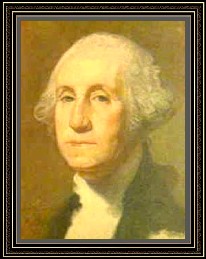
0 Comments:
Post a Comment
Subscribe to Post Comments [Atom]
<< Home